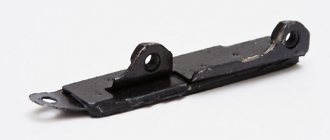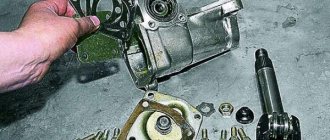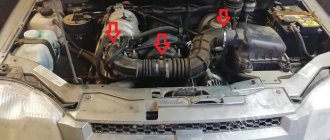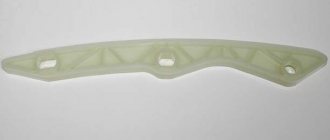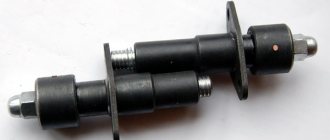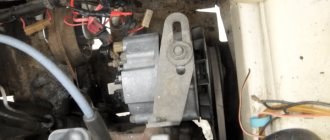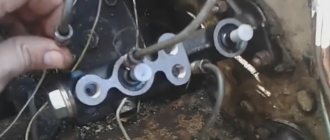The VAZ 2107 has an overhead valve gas distribution mechanism. This means that the camshaft is located at the top of the engine, in the cylinder head. The timing belt is designed to regulate the supply of gas-fuel mixture to the cylinders and organize the removal of exhaust gases. To operate the timing gear, a sprocket gear is installed, the drive of which on the VAZ 2107 injection engine is a chain with special devices.
Timing chain for VAZ 2107
VAZ 2107 TIMING CHAIN DRIVE - DESCRIPTION
The VAZ 2107 timing chain transmission has a long service life, but someday it’s time to replace it. The need for this arises as a result of stretching of the links, when the chain tensioner can no longer cope with the functions assigned to it. In addition, the parts responsible for the normal operation of the timing drive also wear out over time.
The main elements of the VAZ 2107 timing drive are a chain, a damper, a shoe, a tensioner and sprockets
SOOTHER
In the chain drive of the VAZ 2107 gas distribution mechanism, a damper is used to dampen jerks and vibrations of the chain. Without this part, as the vibration amplitude increases, the chain may fly off the gears or break completely. A chain transmission break is most likely at maximum crankshaft speed, which happens instantly. At the moment of a break, the intake and exhaust valves fail. After such damage, the engine will at best require a major overhaul.
The chain damper is designed to dampen vibrations of the chain drive during engine operation.
By its design, the damper is a plate made of high-carbon steel with two holes for fastening. Another element that is simultaneously responsible for calming and tensioning the chain is the shoe. Its rubbing surface is made of high-strength polymer material.
The tensioner shoe provides chain tension, eliminating sagging
TENSIONER
Based on the name, you can understand that the device is designed to prevent sagging of the timing chain while the engine is running. There are several types of such mechanisms:
- automatic;
- mechanical;
- hydraulic.
Automatic tensioners appeared not so long ago, but have already managed to show their positive and negative sides. The main advantage of the product is that there is no need to periodically adjust the chain tension, since the mechanism keeps it constantly taut. The disadvantages of the auto tensioner include quick failure, high cost, and poor tension, as evidenced by reviews from some car owners.
Hydraulic tensioners operate as a result of the action of oil under pressure, which is supplied from the engine lubrication system. This design does not require intervention from the driver in terms of adjusting the chain drive, but the mechanism can sometimes jam, which negates all its advantages.
The most common tensioner is mechanical. However, it has a significant drawback: the product becomes clogged with small particles, as a result of which the plunger jams and the mechanism is unable to perform its functions during tension adjustment.
The tensioner provides chain tension and allows for adjustments when needed.
CHAIN
The timing chain in the VAZ 2107 engine is designed to connect the crankshaft and camshaft: they have gears on which the chain is put. After starting the power unit, synchronous rotation of the indicated shafts is ensured through a chain transmission. If synchronization is disrupted for any reason, the timing mechanism malfunctions, resulting in the stable operation of the engine being disrupted. In such a situation, power failures, deterioration in dynamics, and increased fuel consumption are observed.
The timing chain in the VAZ 2107 engine is designed to connect the crankshaft and camshaft
As the vehicle is used, the chain stretches as high loads are placed on it. This indicates the need for periodic adjustment. Otherwise, the sagging will lead to the links on the gears jumping, which will disrupt the operation of the power unit. To prevent this from happening, the factory recommends adjusting the chain tension every 10 thousand km. mileage
Even if there are no characteristic sounds (rustling) indicating chain stretching, it is advisable to check the tension, especially since the procedure is simple and will not take much time.
Possible faults
In the family of cars of the Volzhsky Automobile Plant, which are called “classics”, the timing drive is made in a chain version. The service life of a good double-row chain is longer than any belt, and the chain is better protected from any external influences while being inside the engine block. Instant stretching of the chain is excluded; moreover, the chain, unlike the belt, will not slip when the engine is suddenly revved up. The downside: noise and some cumbersomeness are not so noticeable when operating the VAZ-2107.
Tensioner diagram: 1 — camshaft sprocket; 2 - timing chain; 3 — chain damper; 4 — auxiliary drive sprocket; 5 — crankshaft sprocket; 6 — tensioner shoe; 7 — hydraulic chain tensioner; 8 - oil line fitting
Unfortunately, the chain also does not last forever. It also stretches - only not immediately, but gradually, as a result of the metal fingers working against the gear teeth.
Signs that the chain has stretched and you need to diagnose the degree of its serviceability are the following:
- extraneous knocking and clanking when the engine is running;
- severe stretching and metal wear can lead to irregular valve timing, increased fuel consumption and other malfunctions.
If the chain has only slightly stretched, you can compensate for the sag by increasing the pressure with the tensioner shoe. When the limit of adjustments has been exhausted, only replacing the chain can help.
Chain stretch even of a few millimeters is noticeable to the eye
In order to better understand when you can get by with little blood and when to change the chain, the manufacturer has established the approximate resource for normal operation of the timing drive, which on the “seven” is 60 thousand kilometers. When used beyond the specified period, there is a risk of not just stretching, but the teeth jumping during operation, or the unit breaking.
Jumping the chain by one or two gear teeth leads to a violation of the valve timing, which will affect malfunctions even at idle speed, not to mention operation under load.
An open circuit leads to the disappearance of synchronization between the revolutions of the crankshaft and camshaft. As a result, the pistons, by inertia, hit the valves open inside the cylinder, deform themselves and deform them. The pistons of the “seven” engine have special grooves that protect the valves from bending. But if the engine has undergone a major overhaul with the replacement of the cylinder-piston group, the pistons may well not have recesses, then the risk of serious damage increases. Monitor the drive chain and change it on time.
SIGNS AND CAUSES OF CHAIN DRIVE MALFUNCTION
The timing chain drive, unlike the belt drive, is located inside the engine and in order to assess the condition of the elements, partial disassembly of the power unit will be required. There are certain signs that indicate that not everything is in order with the chain drive and it needs to be tensioned or replaced.
THE CHAIN RATTLES
Problems with the circuit may manifest themselves as follows:
- rattles when cold;
- knocks on hot;
- there is extraneous noise during load;
- constant metallic sound.
If extraneous noise appears, it is recommended to visit a service station in the near future or independently deal with the problems in the timing drive and evaluate the condition of all elements responsible for its operation (tensioner, shoe, damper, chain, gears). If you continue to drive a car with a rattling chain, wear on parts increases.
Due to damage or breakdown of timing drive elements, the chain may rattle
The main reasons that lead to failure of timing belt components are:
- failure to promptly change the engine oil or use a brand other than that recommended by the manufacturer;
- use of low quality spare parts (non-original);
- low engine oil level or low pressure;
- untimely maintenance;
- improper operation;
- poor quality repairs.
One of the likely reasons that the chain begins to rattle is its stretching and a malfunction of the tensioner. As a result, the chain drive cannot be tensioned properly, and a uniform noise appears in the motor, similar to the operation of a diesel engine. In most cases, the sound is heard when idling on a cold engine.
VIDEO: WHY THE CHAIN RATTLES ON THE CLASSIC
JUMPED THE CHAIN
With low tension, the chain stretches quite quickly and can jump on the gear teeth. This is possible as a result of a broken shoe, tensioner or damper. If the chain has jumped, then a strong ignition bias occurs. In this case, it is necessary to troubleshoot the drive parts of the gas distribution mechanism.
Symptoms of loose chain tension
In principle, the symptoms are quite specific, and it is very, very difficult to confuse them with something else.
- Increased engine noise, even at idle speed;
- Instant increase in noise during a sharp increase in speed;
- The roar increases proportionally with a smooth increase in speed, and decreases gradually with a sharp release of the gas pedal;
- Most often, a loose VAZ 2107 chain rattles because the damper has broken and needs to be replaced.
However, let’s say that this is not the case, and we just need some tension. To work, we will need a special key to turn the crankshaft; on carburetor cars, you can turn it using a ratchet.
CHAIN TENSION
Every owner of this car should know how to tension the timing chain on a VAZ 2107. To carry out the work you need to prepare:
- key to 13;
- 36mm wrench to rotate the crankshaft;
- hammer.
The procedure is carried out in the following order
- Using a 13mm wrench, unscrew the tensioner cap nut.
- Using a crankshaft wrench, turn the pulley several turns.
- Stop the crankshaft at the moment of maximum resistance to rotation. In this position we perform tension.
- We tighten the cap nut.
VIDEO: CHAIN TENSIONING ON THE “CLASSIC”
Sometimes it happens that when you unscrew the nut, the tensioner does not snap off. To do this, you need to knock on the mechanism body with a hammer.
To understand whether the chain really has good tension, you must first remove the valve cover before making adjustments.
Features of replacing the tensioner shoe
If a complete replacement is made, along with the shoe, then the operation becomes much more complicated.
The entire sequence of work to remove the shoe is described here.
In short, in addition to removing the tension mechanism, you will also need to dismantle the drive pulleys in the front part of the engine, the drive cover, the camshaft sprockets and the auxiliary shaft.
Only then will it be possible to remove the shoe for replacement.
Most VAZ-2107 cars were equipped with a carburetor power system.
But the latest models came with an injector. Although the sequence of replacing the timing chain tensioner does not change.
TYPES OF CHAIN DRIVE
The VAZ “Seven”, like other “classics”, is equipped with a double-row timing chain. However, there is a single-row chain that, if desired, can be installed on a Zhiguli.
SINGLE ROW CHAIN
A chain drive with one row has less noise when the engine is running compared to two rows. This factor is one of the main factors in favor of choosing single-row chains. Therefore, some VAZ 2107 owners decide to replace the timing drive. The lower noise level is due to the fact that fewer links are driven. Plus, it is easier for the entire engine to rotate such a chain, which has a positive effect on the increase in power. However, due to the low noise level when such a chain is stretched, it is not always clear that the part needs tension.
Single row timing chain has lower noise levels
DOUBLE-ROW CHAIN
Despite the advantages of a single-row chain, a chain drive with two rows is the most common, since it is characterized by high reliability and if a link breaks, the entire chain does not break. In addition, the load on the timing drive parts is distributed evenly, as a result of which the chain and gears wear out more slowly. The life of the part in question exceeds 100 thousand km. Although recently, in order to reduce the weight of power units, automakers have been installing chains with one row.
The double-row chain, despite its higher noise level, has a long service life
REPLACING A DOUBLE-ROW CHAIN WITH A SINGLE-ROW CHAIN
If you are thinking about replacing a double-row chain drive with a single-row one, you will need to purchase the following parts:
- crankshaft, camshaft and oil pump gears for single row chain;
- sedative;
- shoe;
- single-row chain;
- automatic tensioner.
To install a single row chain, you will need to replace the gears, chain, guide and timing chain tensioner
All of the listed parts are taken, as a rule, from the VAZ 21214. Replacing the chain should not cause difficulties. The only thing that is required is to replace the sprockets, for which you unscrew the corresponding fasteners. Otherwise, the steps are similar to the procedure for replacing a conventional double-row chain.
VIDEO: INSTALLING A SINGLE-ROW CHAIN ON A VAZ
Despite the fact that replacing the timing chain drive on a VAZ 2107 is not an easy process, every owner of a Zhiguli can do it if you follow the step-by-step instructions. The main thing is to correctly set the marks upon completion of the work, which will ensure synchronous operation of the crankshaft and camshaft.
Automatic tensioner system
Some car owners of classic VAZs replace the standard chain tensioner with an automatic one of the “Pilot” type. The automatic tensioner does not require maintenance after installation and, without the intervention of a technician, ensures that the chain is tightened as it stretches. The advantages of the Pilot device include:
- no need to supply an oil line, which eliminates chafing of the VAZ 2107 injector timing chain and loss of oil pressure;
- the absence of plunger elements, which is why the automatic chain tensioner “Pilot” does not jam;
- the movement step is 1 mm, which allows you to regularly monitor the degree of tension;
- no shoe wear;
- reduction of motor noise;
- increasing the service life of all timing components;
- long service life - about 25 years.
The “Pilot” chain tensioner improves the performance of the VAZ 2107 injector engine due to the precise execution of valve timing. The process associated with how to tension the chain is carried out regardless of the operation of the car engine.
This article will discuss how to tighten the chain on a VAZ 2107 yourself. The procedure is quite simple and you can do it yourself, although it is better together.
Adjusting chain tension on a VAZ 2107
In the article we will tell you why you need to adjust the tension of the timing chain, what can happen if this is not done, and how to tension the chain on a VAZ 2107.
When is chain tension adjusted?
- if the chain is stretched. This is indicated by the appearance of a high-pitched ringing sound with a metallic tint from the front side of the engine, in the end part, or a knock from under the valve covers. This can be heard clearly when the engine revs up.
- if the chain has been removed or the engine has been repaired.
- before valve clearances must be adjusted;
- after changing the damper or tensioner.
- A tightening is needed after long-term use, after a mileage of 10-20 thousand km.
What are the dangers of untimely lifting?
The valve timing gradually shifts, the engine begins to operate intermittently, and increased heating and wear of the cylinder-piston group parts occurs.
What tool is needed for tensioning?
- simple open-end wrench 13;
- open-end wrench for cranking the crankshaft by 38;
- tubular wrench size 10 for removing the cylinder head cover.
Sequence of necessary operations:
1. Remove the air filter housing from the carburetor. Then disconnect the throttle link from the roller
2. Then you need to remove the lever with rods.
3. And finally, disconnect the fuel hose from the bracket that goes from the fuel pump to the carburetor.
4. Using a 10 mm tubular wrench, remove the cylinder head cover. This must be done so that you can check the chain tension by hand.
5. Loosen the tensioner. In the engine housing, near the pump, on the right side in front along the direction of the car, unscrew the cap nut with a 13 mm wrench.
6. The chain tensioner discharges, the shoe “clicks” with a specific sound. If there is no click and the tensioner is “stuck,” then you can gently tap the nut with a hammer and release the tensioner plunger.
7. With the cover open, you can easily determine whether the chain is slack by pressing on the side. It is worth remembering what degree of “weakness” it has.
8. Using an open-end wrench 38, turn the crankshaft clockwise by an average of one and a half to two turns. When the greatest resistance to movement arises, then the chain will be stretched to its maximum. The main thing is to ensure that the crankshaft does not turn back due to compression and that the chain tension does not weaken. If you don’t have a key for 38, you can turn on the ignition and turn the crankshaft with the starter. In order not to “overshoot” the torque and tighten the chain, skill is required, because you need to turn on the starter for a split second. You can even turn the crankshaft without a key and without a battery. You will have to hang the rear axle and engage the “easiest” 5th gear to rotate. Then, turning the wheel clockwise, rotate the chain to the desired position.
9. Tighten the nut back, holding the crankshaft from “shock absorption” back. Then we check the tension result by pressing the chain with our hand again.
There should be no deflection. Now we install the block head cover in place.
10. The adjustment is complete. Now we start the engine and check the operation by ear. If you managed to tighten the timing chain correctly, the metallic ringing will disappear.
This method of tension can be recommended to everyone. Experienced car enthusiasts do not need to remove the cylinder head cover, provided that by touch and by resistance they can unmistakably find exactly the position of the crankshaft at which the chain will be as tight as possible.
Installing the chain by marks
The need to install marks on the timing mechanism may arise during the repair process or when the chain is severely stretched. If the marks do not match, the stable operation of the motor is disrupted due to a phase shift. In this case, an adjustment is required. The work is carried out with the following tools:
- Screwdriver Set;
- key for rotating the crankshaft;
- a set of keys.
We carry out the procedure according to the following instructions:
- We dismantle the air filter box and the valve cover with the seal by unscrewing the fasteners.
- Loosen the tensioner clamp, press the screwdriver against the shoe and tighten the nut.
- Using a 38 mm wrench or a crank, turn the crankshaft until the marks on its pulley and the timing cover match, and the mark on the camshaft sprocket should be located opposite the protrusion cast on the body.
- If any of the marks do not coincide, turn on the fourth speed and unbend the lock washer on the camshaft sprocket.
- We unscrew the bolt and remove the gear.
- Remove the chain from the sprocket and set the desired position (step 3). After installing the marks, we perform reverse assembly.
Video: how to set timing marks on classic Zhiguli cars
How to properly tension a chain on a VAZ-2107
The timing chain drive on the VAZ-2107 is designed for a long service life.
But it can also fail. If excessive pressure is applied to the tensioner, the links are stretched and the mechanism begins to work worse. In addition, all drive components also wear out. To dampen jerks and vibrations of the chain, a damper is installed. If this part is missing, then with strong jerks the chain will begin to fly off the gears. The operation of the intake and exhaust valves will also stop. Serious damage will lead to complex repairs.
The tensioner is needed to support the chain and prevent it from sagging. It comes in three types:
- mechanical;
- auto;
- hydraulic.
Tensioners with automatic operation began to be produced recently, but their pros and cons are already known. The advantage is that you do not need to adjust the chain every time, since it is already tense all the time. The disadvantage is that the mechanical tensioner is weak, often breaks and is not cheap. Please note that on VAZ cars the carburetor and injector operate the same.
The operation of the hydraulic tensioner depends on the transfer of oil that leaves the engine's lubrication circuit. This design solution is advantageous in that the driver does not need to independently regulate the operation of the chain drive.
The most common tensioner is mechanical. Its disadvantage is that small particles get into the product, and the plunger begins to jam. The mechanism fails and the tension drops.
Useful notes
If you have a “seven” with a carburetor, then after replacing the timing chain you need to adjust the ignition, because the drive sprocket of the ignition distributor-distributor (in common parlance, distributor) was also removed from its seat. Injection models do not require such adjustment.
Soviet and early Russian cars of the classic family were traditionally equipped with double-row timing chains. This provided increased reliability due to the fact that the break of one link did not provoke an instant collision of the piston with the valve in the open position. The disadvantage was the increased weight. In order to save money and simplify the design, the chain began to be made single-row. The resource of a double chain reaches 100 - 120 thousand kilometers, while a single chain is half as much. Some car owners are returning a double-row chain to their power units. True, for this you will also have to replace all the gears that mesh with the chain. Today, a set of such parts is quite difficult to find, so get ready for search work if you want to increase the reliability of the timing mechanism.
A double-row timing chain has a much longer life, but choosing a set of parts for its installation is much more difficult
How the timing chain works in the VAZ-2107 engine
Two shafts, crankshaft and camshaft, are connected. Synchronous rotation occurs between them when the power unit starts. The mechanism of the chain is disrupted when the synchronism in the operation of the shafts is lost. There may be several reasons for this. As a result, power decreases, dynamics deteriorate and fuel consumption increases. As a result, you need to change the chain tension.
Since the chain carries heavy loads, over time it fails. Therefore, from time to time it needs to be adjusted and tensioned, otherwise the links will jump on the gears and the operation of the chain will be interrupted. To avoid such troubles, the manufacturer recommends adjusting the chain tension every 10,000 km.
Step-by-step instruction
Before starting work on tensioning the chain, the car must be placed in a comfortable position. Place the gearshift knob in the neutral position and secure the wheels so that the car does not roll during the procedure.
Tools
To carry out the work, the following tools are required:
- set of socket wrenches;
- set of heads;
- pliers;
- screwdriver;
- hammer.
Before starting work, you should make a visual inspection of the chain drive. If mechanical damage is found to the tension roller, shoe, guide, sprockets or chain, the defective parts must be replaced.
Stages
The sequence of work when tensioning the chain both in an engine with an injector and with a carburetor consists of the following steps:
Why does the chain fail?
The reasons are as follows:
- Tensioner discharge. If the shoe does not release when adjusting the chain, the plunger is stuck. You need to take a hammer and knock on the unit.
- Unscrew the cap nut with the 13th wrench.
- Turn the pulley a few turns.
- At maximum resistance, the crankshaft will stop. Conduct voltage.
- Hold the shaft so that it does not spin in the other direction. Tighten the cap nut.
- Install the cylinder head cover.
If the work done did not help, then you need to tighten the chain.
When to adjust tension
The load on the chain is maximum, so it can withstand up to 70-80 thousand kilometers. Don't forget to adjust every 10-15 thousand km. If you notice that there is a rumble, then inspect the system earlier. Before adjusting the tension, check the operation of the timing belt. Check the tension after repairing the system on a VAZ car. The characteristic rustling sound produced by a fallen chain can be recognized immediately. Listen to how the engine idles under the hood. Add speed, and the extra sounds will disappear. This will be a signal that it is time to tighten the tension.
Prepare the engine before adjusting the chain. Place the VAZ car on a horizontal surface and leave it on the handbrake. Then we prepare the engine as follows:
- leave the lever in the neutral position (gear switch);
- use a wrench to remove the cover from the engine;
- replace the old gasket on the cover with a new one.
Having completed these steps, the timing parts, including the chain, will be clearly visible.
Adjusting the drive itself takes little time. But do it carefully and carefully. For work, prepare two wrenches: a 38th open-end wrench and a 13th socket wrench.
Removing the mechanism
The car is placed on a level surface and immobilized with the handbrake.
To partially replace the tensioning mechanism, you do not need to remove anything from the engine. It is enough to unscrew the two nuts securing this element and remove it.
You need to pull it out carefully so as not to damage the gasket located under it.
But if this one came complete with a new tensioner, then it is not necessary to monitor the safety of the old one.
How to tension the chain in a VAZ car yourself
The system consists of a spring-loaded rod, a collet and a shoe. Use a socket wrench to unscrew the cap nut. Moving the shoe will tighten the chain. The fuel hose must be disconnected from the bracket that goes to the carburetor. If the rod is stuck, lightly hit the nut with a hammer several times. Turn the crankshaft a couple of turns with an open-end wrench. It is inconvenient to get to the nut, especially on an injector. To still cope with the injector, find a suitable key. Therefore, rotate the crankshaft through the transmission (the starter cannot be used). Secure the machine on a horizontal platform in advance. Lift the rear wheel and engage 4th or 5th gear and release the brake. Rotate the wheel a turn or one and a half until you feel resistance and stop turning. Leave the open-end wrench in this position. When the tensioner nut is tightened, the adjustment is complete. Put the cover back.
After all the work has been done, start the engine and check the result. If the motor is working properly and no unnecessary sounds are heard, then nothing else needs to be changed.
Source
- ladaprofi.ru/vaz-2107/kak-pravilno-natyanut-tsep-na-vaz-2107.html
- 7vaz.ru/nastrojka/kak-natjanut-cep.html
- bumper.guru/klassicheskie-modeli-vaz/grm/grm-2107/kak-natyanut-tsep-na-vaz-2107.html
- zen.yandex.ru/media/vaganov/kak-natianut-cep-grm-vaz2107-5c87e133b48e4700af8e3e6c?utm_source=serp
VAZ 2105 - replacing the camshaft drive chain
We replace the camshaft drive chain on a VAZ 2105 and other models from the “classic” series if it is not possible to restore the required degree of tension using the usual method using a tensioner. The verdict is clear - the chain has stretched beyond the permissible limits and needs to be replaced. The dismantling work on all types of classic engines is identical, so let’s look at the replacement process using the example of the most popular engine of the VAZ 2103 family. On an injection engine, the sequence of work is also identical with the only difference being that you will have to disconnect the block with wires from the crankshaft position sensor.
To carry out repair work, we prepare a standard set of tools, namely wrenches of different calibers from ten to seventeen, screwdrivers, pliers, etc. There is no need to drive the car into a pit for repairs. If you have everything you need, we begin the process, the sequence of actions of which is as follows:
Unscrew the bolt securing the auxiliary device sprocket
To prevent the sprocket from turning, carefully fix it with a flat screwdriver by inserting the rod between the teeth and resting the screwdriver against the cylinder block. After the bolt is unscrewed, using a small mounting blade, pull the sprocket off the shaft
After removing the camshaft sprocket, auxiliary devices, crankshaft (if required), it is strictly forbidden to turn the crankshaft, auxiliary shaft and camshaft, as this will lead to a failure of the ignition system and the car will not start during assembly.
After removing the old chain, you can begin installing the new one. The new chain is put on the auxiliary sprocket, after which the sprocket itself is installed in its place and secured with a fastening bolt (do not forget to install a new lock washer).
Prepare a long metal hook, use it to pick up the chain from above and pull it towards the camshaft sprocket. Place the chain on the sprocket. Secure the sprocket and bend the tabs of the lock washer.
All. At this point, the process of replacing the old camshaft drive chain of the VAZ 2105 can be considered complete. At the final stage, install the tensioner, tensioner shoe and chain guide and stop pin in the reverse order of removal. Check the tightness of all bolts securing system elements. Turn off the speed and parking brake and turn the crankshaft a few revolutions and check the alignment of the marks on the sprocket and the camshaft bearing cap. If the marks do not match, then it is necessary to throw the chain onto the link either forward or backward. If the installation was successful and the marks match, tighten the tensioner cap nut. Check and adjust the ignition if necessary. This completes the repair work.
